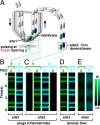The chemistrode: a droplet-based microfluidic device for stimulation and recording with high temporal, spatial, and chemical resolution
- PMID: 18974218
- PMCID: PMC2579341
- DOI: 10.1073/pnas.0807916105
The chemistrode: a droplet-based microfluidic device for stimulation and recording with high temporal, spatial, and chemical resolution
Abstract
Microelectrodes enable localized electrical stimulation and recording, and they have revolutionized our understanding of the spatiotemporal dynamics of systems that generate or respond to electrical signals. However, such comprehensive understanding of systems that rely on molecular signals-e.g., chemical communication in multicellular neural, developmental, or immune systems-remains elusive because of the inability to deliver, capture, and interpret complex chemical information. To overcome this challenge, we developed the "chemistrode," a plug-based microfluidic device that enables stimulation, recording, and analysis of molecular signals with high spatial and temporal resolution. Stimulation with and recording of pulses as short as 50 ms was demonstrated. A pair of chemistrodes fabricated by multilayer soft lithography recorded independent signals from 2 locations separated by 15 mum. Like an electrode, the chemistrode does not need to be built into an experimental system-it is simply brought into contact with a chemical or biological substrate, and, instead of electrical signals, molecular signals are exchanged. Recorded molecular signals can be injected with additional reagents and analyzed off-line by multiple, independent techniques in parallel (e.g., fluorescence correlation spectroscopy, MALDI-MS, and fluorescence microscopy). When recombined, these analyses provide a time-resolved chemical record of a system's response to stimulation. Insulin secretion from a single murine islet of Langerhans was measured at a frequency of 0.67 Hz by using the chemistrode. This article characterizes and tests the physical principles that govern the operation of the chemistrode to enable its application to probing local dynamics of chemically responsive matter in chemistry and biology.
Conflict of interest statement
The authors declare no conflict of interest.
Figures




References
-
- Hamill OP, Marty A, Neher E, Sakmann B, Sigworth FJ. Improved patch-clamp techniques for high-resolution current recording from cells and cell-free membrane patches. Pflugers Arch. 1981;391:85–100. - PubMed
-
- Wightman RM. Probing cellular chemistry in biological systems with microelectrodes. Science. 2006;311:1570–1574. - PubMed
-
- Kennedy RT, Thompson JE, Vickroy TW. In vivo monitoring of amino acids by direct sampling of brain extracellular fluid at ultralow flow rates and capillary electrophoresis. J Neurosci Methods. 2002;114:39–49. - PubMed
-
- Cellar NA, Burns ST, Meiners JC, Chen H, Kennedy RT. Microfluidic chip for low-flow push–pull perfusion sampling in vivo with on-line analysis of amino acids. Anal Chem. 2005;77:7067–7073. - PubMed
Publication types
MeSH terms
Substances
Grants and funding
LinkOut - more resources
Full Text Sources
Other Literature Sources

